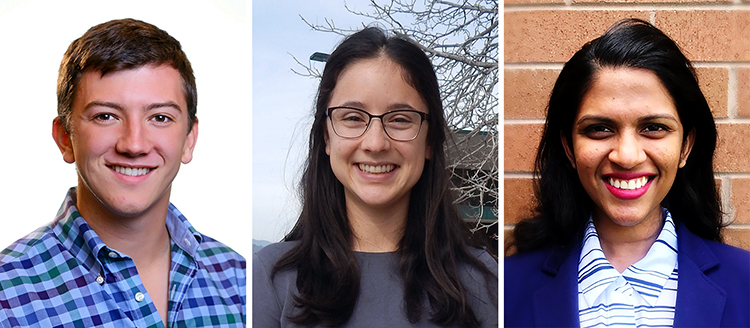Three grad students in Barnes research group earn AGU, AMS honors
Three graduate students in Associate Professor Elizabeth Barnes’ research group recently were awarded honors from the American Geophysical Union and American Meteorological Society. Ben Toms won two awards, an Outstanding Oral Presentation Award from the AMS 33rd Conference on Climate Variability and Change, and a second-place Student Oral Presentation Award from the AMS 26th Conference on Probability and Statistics. Both Andrea Jenney, who is co-advised by Professor Dave Randall, and Savini Samarasinghe, an electrical engineering student co-advised by Imme Ebert-Uphoff, received Outstanding Student Presentation Awards from the 2019 AGU Fall Meeting.
“We have a talented team in the Barnes group working on machine learning and climate predictability problems,” Toms said. “It’s exciting that the community also recognizes this through these awards!”
In Toms’ second-place presentation, “Physically interpretable neural networks for the geosciences,” he showed that a few neural network interpretability methods open the door to using neural networks for science. In “Using neural networks to identify forecasts of opportunity for decadal prediction,” he discussed how to identify climate states that lead to increased predictability on decadal timescales using neural networks and neural network interpretability methods.
The circulation of the atmosphere is expected to weaken in a future warmer climate. Despite a predicted increase in precipitation, the average strength of stormy updrafts is anticipated to decrease near the surface. Jenney’s talk, “Scale Dependence of Changes in Large-Scale Vertical Motion and Convective Mass Fluxes in a Future, Warmer Climate,” demonstrated that while circulation weakens, the stormy updrafts actually can strengthen aloft, due to changes in the clouds and vertical motion between the storms.
Samarasinghe’s poster, “Using Causal Discovery Methods to Explore Subseasonal Teleconnections in a Changing Climate,” presented collaborative research with Barnes, Ebert-Uphoff, and Lantao Sun, a research scientist with Professor Jim Hurrell’s group.
“We investigated the tropospheric and stratospheric teleconnections between the MJO and the NAO using causal discovery approaches,” Samarasinghe explained. “We also looked into how these interactions change in future climate projections using the CESM2 model.”



